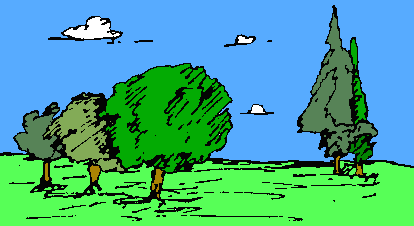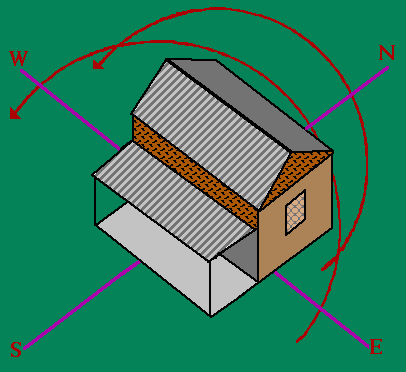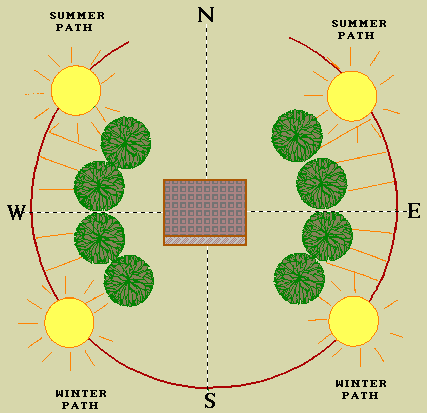REDUCING HEAT GAIN WITH VEGETATION
- GOAL:
- The student will recognize the need to reduce energy consumption while providing better human comfort.
- OBJECTIVE:
- The student will be able to understand how properly placed vegetation around the home can provide natural cooling.
- LESSON/INFORMATION:
- The major way climate is controlled is by adjusting the thermostat in the home. However, the landscaping around the home has a large effect on temperature, air movement, and humidity. Vegetation is also beneficial in the winter to block the winds that remove heat from the home.
- The most obvious use of trees for landscaping in Louisiana is to shade windows, walls, and roofs and to reduce solar heat gain that penetrates to the interior of the home. However, there are other ways vegetation can be used to cool the home.
- The area surrounding the home has a direct impact on air temperature. Paved surfaces, especially blacktop, absorb huge amounts of heat from the sun and radiate it back into the surrounding air. By shading these outdoor areas, the air temperature can be kept down. This will result in lower indoor temperatures. If hard surfaces are required, a product called "grasscrete can be used. It provides a hard surface but allows grass to grow through it to provide a cooler surface. Of course, a shaded grass lawn would be the best option to surround the home.
- The cooling effect of vegetation is also enhanced by the process of evapotranspiration. A single tree absorbs as much as 600,000 Btu of solar radiation every day and evaporates water into the air. This maintains lower temperatures that drop toward the ground and move the warmer temperatures up (by convection) and away from the home. Trees literally are nature's air conditioners.

- In using trees to shade the home, it must be taken into consideration that during the heating season (winter), the heat gain from the sun is very beneficial. The ideal situation is to place trees so that they provide shading during the cooling season, but not during the heating season.
- One way of doing this is by using deciduous trees -- those trees that lose their leaves during the winter. However, even bare-branched trees can block 30 to 60 percent of the desired sunshine in the winter.
- The best approach is to have a good understanding of the sun's path during the summer and the winter. During the summer, the sun rises far to the northeast, is very high in the sky during the middle of the day, and sets in the northwest for about 13 hours of daylight at the summer solstice. At the winter solstice, the sun rises in the southeast, is much lower in the sky during the middle of the day, and sets in the southwest for about 9 hours of sunlight.
- As you can see from the sun graph, the sun is so high when it is on the south side of the home that the trees would need to be against the south side of the home for shading. However, it is not always desirable to have trees that close to the home. Some variety of trees can damage foundations, clog drainage lines, and block gutters with leaves. A simple overhang on the south side is all that is needed to keep the south wall in shade.

- Trees are best used to shade the east and west walls of the home. The sun is much lower in the sky during the morning and afternoon, and the overhang will not protect the east and west walls. As the diagram below shows, well placed trees on the east and west will provide summer shading and allow winter heat gain.

- RECOMMENDED READING:
- Cazayoux, E., A. Hebert and D. Winn, Natural Louisiana Architecture; Designing for Comfort and Energy, Louisiana Dept. of Natural Resources, Baton Rouge, Louisiana, 1991
- New Shelter; Trees for Solar Control, David Rodale, July/August, 1984.
- INFORMATION CHECK
- Q1. Based on the information about shading, what is the ideal house shape and orientation?
- Q2. Define evapotranspiration.
- Q3. Why are summer days much longer than winter days? How many hours difference is there between summer days and winter days?
- Q4. What are deciduous trees?
- TEACHER'S NOTES
- Students will need to become familiar with the following vocabulary words to better understand this activity guide:
- VOCABULARY:
- Btu (British Thermal Unit) -
- A unit used to measure the quantity of heat; technically, the quantity of heat required to raise the temperature of one pound of water one degree Fahrenheit. One Btu is approximately equal to the amount of heat given off by burning one kitchen match. One Btu equals 252 calories and 3410 Btu equals one Kilowatt hour.
- Deciduous -
- species of vegetation which shed their leaves in the autumn.
- Evapotranspiration -
- the process of transferring moisture from the earth to the atmosphere by evaporation of water and transpiration from plants.
- Grasscrete -
- a hard surface which allows grass to grow through it to provide cooler surfaces.
- Solstice -
- that time of the year when the sun is at its greatest distance (summer) or shortest distance (winter) from the celestial equator. At the summer solstice (around June 22nd) the sun reaches its highest zenith at approximately 83° above the horizon. During the winter solstice (around December 22nd) the lowest zenith is approximately 33° above the horizon. The summer solstice is the longest (about 13 hour) day of the year, while the winter solstice is the shortest (about 9 hours of daylight).
- ANSWERS TO INFORMATION CHECK:
- Q1. Area should be rectangular with long walls facing North and South and the shorter walls facing East and West. This allows for maximum shading in summer and heat gain the winter.
- Q2. Evapotranspiration is the process of transferring moisture from the earth to the atmosphere by evaporation of water and transpiration of plants.
- Q3. During the summer, the sun rises far to the northeast, is very high in the sky during the middle of the day, and sets in the northwest for about 13 hours of daylight during the summer solstice. During the winter solstice, the sun rises in the southeast, is much lower in the sky during the middle of the day, and sets in the southwest for about 9 hours of sunlight. This accounts for a 4 hour difference between the summer and winter daylight hours.
- Q4. Deciduous trees are trees which shed their leaves in the autumn.
Comments or questions to: TechAsmt@LA.GOV
Return to Comfort Menu





